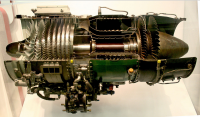








A gas turbine, also called a combustion turbine, is a type of internal combustion engine. It has an upstream rotating compressor coupled to a downstream turbine, and a combustion chamber in-between.
The basic operation of the gas turbine is similar to that of the steam power plant except that air is used instead of water. Fresh atmospheric air flows through a compressor that brings it to higher pressure. Energy is then added by spraying fuel into the air and igniting it so the combustion generates a high-temperature flow. This high-temperature high-pressure gas enters a turbine, where it expands down to the exhaust pressure, producing a shaft work output in the process. The turbine shaft work is used to drive the compressor and other devices such as an electric generator that may be coupled to the shaft. The energy that is not used for shaft work comes out in the exhaust gases, so these have either a high temperature or a high velocity. The purpose of the gas turbine determines the design so that the most desirable energy form is maximized. Gas turbines are used to power aircraft, trains, ships, electrical generators, or even tanks.
50: Hero's Engine (aeolipile) — Apparently, Hero's steam engine was taken to be no more than a toy, and thus its full potential not realized for centuries.
1500: The ""Chimney Jack"" was drawn by Leonardo da Vinci: Hot air from a fire rises through a single-stage axial turbine rotor mounted in the exhaust duct of the fireplace and turning the roasting spit by gear/ chain connection.
1629: Jets of steam rotated an impulse turbine that then drove a working stamping mill by means of a bevel gear, developed by Giovanni Branca.
1678: Ferdinand Verbiest built a model carriage relying on a steam jet for power.
1791: A patent was given to John Barber, an Englishman, for the first true gas turbine. His invention had most of the elements present in the modern day gas turbines. The turbine was designed to power a horseless carriage.
1872: A gas turbine engine was designed by Franz Stolze, but the engine never ran under its own power.
1894: Sir Charles Parsons patented the idea of propelling a ship with a steam turbine, and built a demonstration vessel, the Turbinia, easily the fastest vessel afloat at the time. This principle of propulsion is still of some use.
1895: Three 4-ton 100 kW Parsons radial flow generators were installed in Cambridge Power Station, and used to power the first electric street lighting scheme in the city.
1899: Charles Gordon Curtis patented the first gas turbine engine in the USA (""Apparatus for generating mechanical power"", Patent No. US635,919).
1900: Sanford Alexander Moss submitted a thesis on gas turbines. In 1903, Moss became an engineer for General Electric's Steam Turbine Department in Lynn, Massachusetts.While there, he applied some of his concepts in the development of the turbosupercharger. His design used a small turbine wheel, driven by exhaust gases, to turn a supercharger.
1903: A Norwegian, Ægidius Elling, was able to build the first gas turbine that was able to produce more power than needed to run its own components, which was considered an achievement in a time when knowledge about aerodynamics was limited. Using rotary compressors and turbines it produced 11 hp (massive for those days).
1906: The Armengaud-Lemale turbine engine in France with water-cooled combustion chamber.
1910: Holzwarth impulse turbine (pulse combustion) achieved 150 kilowatts.
1913: Nikola Tesla patents the Tesla turbine based on the boundary layer effect.
1920s The practical theory of gas flow through passages was developed into the more formal (and applicable to turbines) theory of gas flow past airfoils by A. A. Griffith resulting in the publishing in 1926 of An Aerodynamic Theory of Turbine Design. Working testbed designs of axial turbines suitable for driving a propellor were developed by the Royal Aeronautical Establishment proving the efficiency of aerodynamic shaping of the blades in 1929.
1930: Having found no interest from the RAF for his idea, Frank Whittle patented the design for a centrifugal gas turbine for jet propulsion. The first successful use of his engine was in April 1937.
1932: BBC Brown, Boveri & Cie of Switzerland starts selling axial compressor and turbine turbosets as part of the turbocharged steam generating Velox boiler. Following the gas turbine principle, the steam evaporation tubes are arranged within the gas turbine combustion chamber; the first Velox plant was erected in Mondeville, France.
1934: Raúl Pateras de Pescara patented the free-piston engine as a gas generator for gas turbines.
1936: Hans von Ohain and Max Hahn in Germany were developing their own patented engine design.
1936 Whittle with others backed by investment forms Power Jets Ltd
1937, the first Power Jets engine runs, and impresses Henry Tizard such that he secures government funding for its further development.
1939: First 4 MW utility power generation gas turbine from BBC Brown, Boveri & Cie. for an emergency power station in Neuchâtel, Switzerland.
1946 National Gas Turbine Establishment formed from Power Jets and the RAE turbine division bring together Whittle and Hayne Constant's work